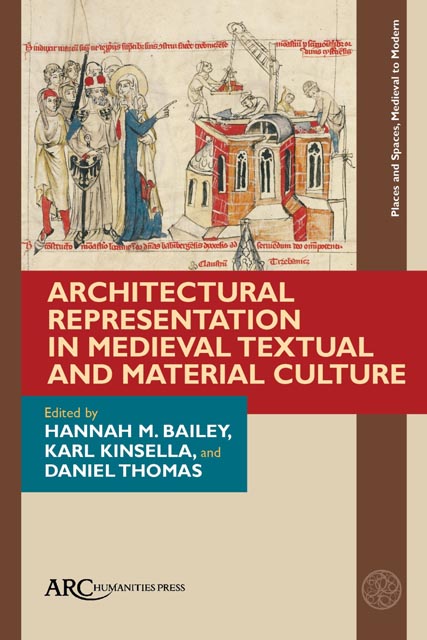Book contents
- Frontmatter
- Contents
- List of Illustrations
- Acknowledgements
- Introduction: Architectural Representation in Medieval Textual and Material Culture
- Chapter 1 Designing the Regensburg Spire and Harburg Tabernacle: The Geometries of Two Great German Gothic Drawings
- Chapter 2 Wilfrid’s Restoration of the Church at York and the Permanence of Sacred Buildings in Post-Conversion Northumbria
- Chapter 3 Heaven-Roofs and Holy Altars: Envisioning a Seventh-Century English Church in Aldhelm’s Carmina Ecclesiastica 3
- Chapter 4 “Beaten Down and Built Anew”: Saint Erkenwald and Old St. Paul’s
- Chapter 5 Castle Viewscapes in Literature and Landscapes
- Chapter 6 Architectural Alignment in Early Medieval English Settlements: Zoning, Meaning, and Function
- Chapter 7 Underneath the Arches: Peter of Eboli and the Orderly Architecture of Norman Sicily
- Chapter 8 Reading the Saint’s Church: A Northern Perspective
- Select Bibliography
- Index
Chapter 3 - Heaven-Roofs and Holy Altars: Envisioning a Seventh-Century English Church in Aldhelm’s Carmina Ecclesiastica 3
Published online by Cambridge University Press: 16 November 2023
- Frontmatter
- Contents
- List of Illustrations
- Acknowledgements
- Introduction: Architectural Representation in Medieval Textual and Material Culture
- Chapter 1 Designing the Regensburg Spire and Harburg Tabernacle: The Geometries of Two Great German Gothic Drawings
- Chapter 2 Wilfrid’s Restoration of the Church at York and the Permanence of Sacred Buildings in Post-Conversion Northumbria
- Chapter 3 Heaven-Roofs and Holy Altars: Envisioning a Seventh-Century English Church in Aldhelm’s Carmina Ecclesiastica 3
- Chapter 4 “Beaten Down and Built Anew”: Saint Erkenwald and Old St. Paul’s
- Chapter 5 Castle Viewscapes in Literature and Landscapes
- Chapter 6 Architectural Alignment in Early Medieval English Settlements: Zoning, Meaning, and Function
- Chapter 7 Underneath the Arches: Peter of Eboli and the Orderly Architecture of Norman Sicily
- Chapter 8 Reading the Saint’s Church: A Northern Perspective
- Select Bibliography
- Index
Summary
The Carmina Ecc lesiastica form a curious grouping of Latin verses written by the seventh-century West Saxon abbot and bishop Aldhelm of Malmesbury. The poems commemorate churches dedicated to Peter and Paul (CE 1) and the Virgin Mary (CE 2–3), as well as a series of altars dedicated to the apostles in a church of unspecified dedication (CE 4–5). Some of these poems may have been intended to serve as inscriptions known as tituli. CE 1–2 are typical of inscriptions found in late antique and early medieval churches: they are short, primarily hagiographic in focus, and outline the holy deeds of the patron saint of the church while praying for the saint's protection and intercession. CE 4 is comprised of not one but thirteen poems of varying length on altars dedicated to the twelve apostles within a church. Like CE 1–2, the first twelve poems of CE 4 (and CE 5, which is dedicated to Matthias, the apostle who replaced Judas) each briefly recount the deeds, miracles, and martyrdoms of single apostles, and the concluding poem of the sequence serves as an epilogue wherein Aldhelm prays for the apostles’ intercession. However, CE 3 differs from the other poems in this grouping: rather than praising or memorializing a saint, this poem lavishly describes the interior features and furnishings of a church built by an abbess named Bugga. Aldhelm prefaces the architectural and liturgical descriptions in this poem with an encomiastic royal genealogy, praising the West Saxon kings Centwine (who was Bugga's father and probably also his own) and Cædwalla for establishing Wessex as a Christian kingdom by eventually giving up their thrones for the religious life. The exact location of the church commemorated in CE 3 remains unknown, but it is possible that it was part of the minster complex of Aldhelm's Malmesbury.
Literary scholarship on the Carmina Ecclesiastica has primarily focused on establishing the Latin sources for Aldhelm's information, and identifying borrowed Latin phrases and formulae, especially those from hexameter inscriptions on churches and shrines in Rome that Aldhelm may have encountered in situ or through manuscript collections known as syllogae. The CE are often described as compositions in the style of such Roman inscriptions, like the tituli of the fourth-century poet and benefactor of holy sites, Pope Damasus.
- Type
- Chapter
- Information
- Publisher: Amsterdam University PressPrint publication year: 2023



